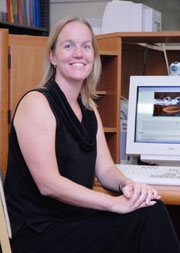  |
| HOME | THIS ISSUE | CALENDAR | GRANTS | BACK ISSUES | < BACK | NEXT > |
Communication sciences prof studies interactions in cyberspaceby Karen Singer - September 17, 2007 | |||||
| In the online world, as in the offline world, first impressions set the stage for social interaction, according to UConn researchers. Recent projects by Kristine Nowak and Christian Rauh found avatars – images representing humans in cyberspace – are perceived as more humanlike and more trustworthy when they have clear male or female characteristics than their androgynous counterparts. A story about their research, which appeared in the July 5 issue of New Scientist, drew widespread national and international press attention.
Nowak, an assistant professor in communication sciences, and Rauh, a Ph.D. student, say research has shown that physical appearance influences perception in face-to-face communication, but little research has been done on how the visual characteristics of the avatar influence person perception online, or on what motivates people to choose particular avatars for various online interactions. The New Scientist article, which summarizes a soon-to-be-published article, “Computers in Human Behavior,” gives an account of two studies. In one study, participants were instructed to “get to know their partner,” but asked not to disclose their name or physical characteristics, such as gender or race. Participants were represented by one of eight avatars during the interaction and interacted with one another by typing text messages using an Instant Messaging software. Avatar images included two male and two female human-like characters, a blonde girl with pigtails and a ketchup bottle with a face. Participants in both studies rated the androgynous avatars as less credible than either masculine or feminine avatars. “What we found was androgynous avatars are perceived as less anthropomorphic (human-like) than distinctly male or female avatars, and the perception of the avatar’s credibility is driving the perception of the person’s credibility,” says Nowak, who has been studying avatars since she was a graduate student. She has been teaching at UConn since 2000, and currently supervises the Human-Computer Interaction Lab in the communication sciences department, where her research concentrates on how people use computer media, and how avatars affect the person perception process. The most recent study, Nowak says, “has implications for how people use the Internet and avatars,” especially at a time when avatars are proliferating on social networking and e-commerce websites. Avatars range from simple images used for text messaging to highly imaginative and sophisticated digital creations in Second Life, a virtual world with five million individuals and more than 7,000 businesses. Nowak notes that businesses are increasingly using avatars for virtual meetings, and some companies are even conducting job interviews with them.
Though press coverage of the UConn study tended to focus on the avatar angle, Nowak says, the results of her research are contributing to an understanding of how people communicate both online and offline. “Discovering that communication processes do not substantially change in cyberspace isn’t shocking,” she says, “because people follow the same rules and processes for getting to know people on and offline.” In initial interactions, she adds, “We want to reduce uncertainty about how the other person is going to behave. The desire to reduce uncertainty is central to most interpersonal interactions.” Because reducing uncertainty appears to be more difficult when interacting with androgynous rather than clearly male or female-looking virtual images, Nowak advises people to craft their avatars carefully. “Spend at least as much time thinking about your online image and the avatar you select to represent you as you do when you present yourself to the offline world, such as when you decide what clothes you’re going to wear for the day,” she says. “Think about the message you’re sending with the avatar you’re choosing, and consider how that might influence what others perceive.” Nowak says she finds it strange, however, that people think they can get to know someone much better when they can see them face-to face rather than interacting online. “Judgments of others in face-to-face interactions are made in an instant, with little cognitive thought,” she says. “People are rarely consciously determining the factors they use in perceiving others, or in detecting deception, but we are very confident in our accuracy and ability to get to know others. When meeting someone face-to-face, such as at a bar, a person may feel confident enough to give another person a phone number after a 15-minute discussion. “On the other hand,” she adds, “we may meet someone online, chat with them for six months, analyzing the text of these messages and think very carefully about who this person is, but still have very little confidence and high uncertainty when we finally meet them face-to-face.” Nowak and her colleagues are seeking additional funding to continue their research. “We next want to use avatars in different ways,” she says. “We want to animate them and put them in different contexts. “We’d also like to put them in an online learning context or marketing context and look at how the avatar credibility ratings change.” |
| ADVANCE HOME UCONN HOME |

